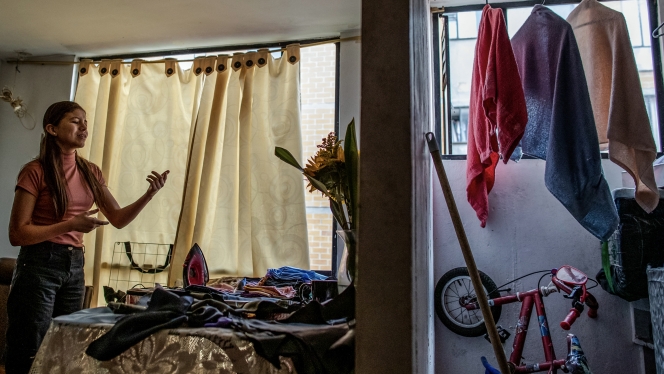![1]()
Gown in dark-green Gros de Tour brocade, England, 1730-1740. This gown with adjusted back is typical of English ladies’ fashion during the 18th century and is outstanding in the quality of its stiff, beautifully brocaded silk, with its pattern of tulips and chrysanthemum flowers. Kunstgewerbemuseum, Staatliche Museen zu Berlin.
![1]()
Jacket ca. 1750. Kunstgewerbemuseum, Staatliche Museen zu Berlin.
![1]()
Bodice, ca. 1750. Kunstgewerbemuseum, Staatliche Museen zu Berlin.
![1]()
![1]()
![1]()
Robe à la française, ca. 1770-75. Kunstgewerbemuseum, Staatliche Museen zu Berlin.
![1]()
Robe à l’anglaise retrouseée, 1770-80. Kunstgewerbemuseum, Staatliche Museen zu Berlin.
![1]()
Robe à l’anglaise retroussée, ca. 1780. Kunstgewerbemuseum, Staatliche Museen zu Berlin.
![1]()
Men suit, German, 1785. Kunstgewerbemuseum, Staatliche Museen zu Berlin.
![1]()
Robe à l’anglaise, ca. 1780. Kunstgewerbemuseum, Staatliche Museen zu Berlin.
![1]()
Men's suit consisting of coat, breeches and vest, made of green-brown velvet and silk, with emb. vest in white silk, France, around 1790. Kunstgewerbemuseum, Staatliche Museen zu Berlin.
![1]()
Dress made of fine cotton in tabby weave and embroidered with white cotton yarn. Embroidered fabric probably from India, dress England, 1785-1800. Collection Kunstgewerbemuseum Berlin. ©Staatliche Museen zu Berlin, Photo: Stephan Klonk
![1]()
Dress, 1805-10. Kunstgewerbemuseum, Staatliche Museen zu Berlin.
![1]()
Green poke hat, made of silk satin, trimmed with silk cord and stiffened with white linen, England, around 1820. Collection Kunstgewerbemuseum Berlin. ©Staatliche Museen zu Berlin, Photo: Stephan Klonk
![1]()
Walking dress, 1820, England, composed of skirt and spencer, in light brown silk with fine pattern and voluminous trimming in silk satin. Kunstgewerbemuseum, Staatliche Museen zu Berlin.
![1]()
![1]()
Dress, ca. 1875. Kunstgewerbemuseum, Staatliche Museen zu Berlin.
![1]()
Worth, housedress, ca. 1882. Kunstgewerbemuseum, Staatliche Museen zu Berlin.
![1]()
Women’s costume in white linen, USA/Europe, around 1895. Kunstgewerbemuseum, Staatliche Museen zu Berlin.
![1]()
Jacket, ca. 1895. Kunstgewerbemuseum, Staatliche Museen zu Berlin.
![1]()
Worth, evening dress ca. 1895. Kunstgewerbemuseum, Staatliche Museen zu Berlin.
![1]()
Doucet, evening cape, ca. 1895. Kunstgewerbemuseum, Staatliche Museen zu Berlin.
![1]()
Ball gown, Jeanne Paquin, 1895, France. Silk, imitation pearls, sequins, lace. Kunstgewerbemuseum, Staatliche Museen zu Berlin.
![1]()
Walking dress, ca. 1900. Kunstgewerbemuseum, Staatliche Museen zu Berlin.
![1]()
Callot Soeurs, evening dress, ca. 1908. Kunstgewerbemuseum, Staatliche Museen zu Berlin.
![DSC_0392]()
Mariano Fortuny, deux robes "Delphos". Kunstgewerbemuseum, Berlin
![1]()
Evening dress by Jeanne Paquin, spring-summer collection, Paris, 1912. This dress in pastel shades combines a tunique in light green silk in tabby weave with a skirt made of cream silk satin. The rose red corset belt accentuates the high waist. Collection Kunstgewerbemuseum Berlin. ©Staatliche Museen zu Berlin, Photo: Stephan Klonk
![1]()
Worth, evening dress ca. 1912. Kunstgewerbemuseum, Staatliche Museen zu Berlin.
![DSC_0395]()
"Ver Luisant", Evening gown, Paul Poiret, Autumn-vinter 1921-1922. Kunstgewerbemuseum, Berlin
![DSC_0399]()
Evening gown with horse motif, n°1113 by Madeleine Vionnet, France-USA, 1921-1924. Kunstgewerbemuseum, Berlin
![1]()
Evening dress designed by Paul Poiret, 1925. Photo Stephan Klonk, Kunstgewerbemuseum, Staatliche Museen zu Berlin.
![1]()
Dancing dress, made of black crêpe georgette, completely embroidered with sequins in silver, grey, gold, rose, blue and black, Paris, around 1925. The sequins made of plastic material make the dress surprisingly light. Collection Kunstgewerbemuseum Berlin. ©Staatliche Museen zu Berlin, Photo: Stephan Klonk
![DSC_0397]()
"Sorrente", dance gown, Jeanne Lanvin, autumn-winter 1927-1928. Kunstgewerbemuseum, Berlin
![1]()
Molyneux, evening dress, ca. 1932. Kunstgewerbemuseum, Staatliche Museen zu Berlin.
![DSC_0401]()
Gold lamé evening gown, Elsa Schiaparelli, Paris, 1933. Kunstgewerbemuseum, Berlin
![1]()
“Cyclone” by Lanvin, 1939. Kunstgewerbemuseum, Staatliche Museen zu Berlin.
![1]()
Brown turban, by “Davis“, Paris, 1940-1945, France - During the Second World War women started to wear turban-like arranged scarfs. The Parisian milliner Davis created a fixed turban form using woollen felt. Kunstgewerbemuseum, Staatliche Museen zu Berlin.
![DSC_0405]()
Coat dress, Christian Dior, Paris, 1948. Kunstgewerbemuseum, Berlin
![1]()
“Artemise” by Yves Saint Laurent for Dior, Fall-Winter 1959. Kunstgewerbemuseum, Staatliche Museen zu Berlin.
![DSC_0403]()
Afternoon dress, Gérard Pipart pour Jacques Fath, Paris, Printemps-Eté 1955. Kunstgewerbemuseum, Berlin
![Cocktail dress with collar, Cristòbal Balenciaga, Paris, 1959]()
Cocktail dress with collar, Cristòbal Balenciaga, Paris, 1959. Kunstgewerbemuseum, Berlin
![Ballon dress with pink pola dots, Cristòbal Balenciaga, Paris, 1954]()
Ballon dress with pink polka dots, Cristòbal Balenciaga, Paris, 1954. Kunstgewerbemuseum, Berlin
![Evening dress by Cristòbal Balenciaga, made of rose red silk in tabby weave, Paris, Spring-Summer 1955]()
Evening dress by Cristòbal Balenciaga, made of rose red silk in tabby weave, Paris, Spring-Summer 1955. Collection Kunstgewerbemuseum Berlin. Staatliche Museum zu Berlin, Photo: Stephan Klonk
![Yellow evening ensemble, Cristòbal Balenciaga, Paris, 1966-67]()
Yellow evening ensemble, Cristòbal Balenciaga, Paris, 1966-67. Kunstgewerbemuseum, Berlin
![Evening cap trimmed with black ribbons, Cristòbal Balenciaga, 1955]()
Evening cap trimmed with black ribbons, Cristòbal Balenciaga, 1955. Kunstgewerbemuseum, Berlin
![Evening cap with feather trimming, Cristòbal Balenciaga, 1960's]()
Evening cap with feather trimming, Cristòbal Balenciaga, about 1960. Kunstgewerbemuseum, Berlin
![Red Turban, Cristòbal Balenciaga, Spain, about 1955]()
Red Turban, Cristòbal Balenciaga, Spain, about 1955. Kunstgewerbemuseum, Berlin
![DSC_0430]()
Minidress with sculptural hemline, Pierre Cardin, Paris, about 1970. Kunstgewerbemuseum, Berlin
![1]()
Cocktail dress "Rib Cage" designed by Pierre Cardin, ca.1970. Photo by Stephan Klonk. Collection Kunstgewerbemuseum, Staatliche Museen zu Berlin.
![DSC_0434]()
Evening skirt with embroidery tunic, Madame Grès, Paris, 1979. Kunstgewerbemuseum, Berlin
![1]()
Madame Grès, evening dress, 1973. Kunstgewerbemuseum, Staatliche Museen zu Berlin.
![DSC_0440]()
Madame Grès, evening dress, 1973 (detail). Kunstgewerbemuseum, Berlin
![DSC_0424]()
Chain with green druze, E.R. Nele Richter, Frankfurt, 1976. Kunstgewerbemuseum, Berlin
![DSC_0426]()
"Frogs" chain, Dorethea Prül, Halle, 1986. Kunstgewerbemuseum, Berlin
![0_fabre1]()
![001f67019928bff463b4daec8c4ced21]()
![1]()
Installation views. Kunstgewerbemuseum, Berlin


















































































































